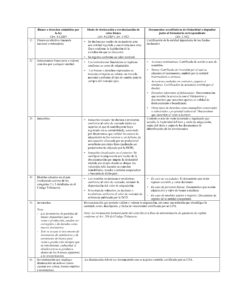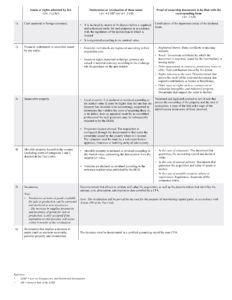La Ley No. 46-20 de Transparencia y Revalorización Patrimonial fue promulgada como un mecanismo para facilitar la implementación de la Ley No. 155-17, contra el Lavado de Activos y el Financiamiento del Terrorismo.
Ésta supone la habilitación de un régimen tributario especial de carácter transitorio aplicable en todo el territorio nacional en beneficio de personas físicas, jurídicas y sucesiones indivisas para que de manera voluntaria y excepcional regularicen o transparenten sus bienes muebles e inmuebles por medio de una declaración, revalorización conforme a los precios del mercado y efectuación del pago correspondiente ante la DGII. (Arts. 1-3 LTRP)
Este régimen tributario especial establece un impuesto del 2% sobre el valor total de los bienes declarados voluntariamente como pago único y definitivo, cuya base imponible se determinará dependiendo del modo de declaración o revalorización aplicable al tipo de bien o derecho admitido por la ley en cuestión. (Art. 7 LTRP)
Estos bienes o derechos admitidos son:
*Para transparentar y revalorizar estos bienes o derechos, debe completarse el formulario de Solicitud Ley de Transparencia y Revalorización Patrimonial. Si se quiere rectificar o saldar deudas tributarias, debe completar el formulario de Solicitud de Facilidades de Pago. (Art. 2 NG)
Bienes o derechos excluidos. No pueden ser objeto de declaración y/o revalorización: (Art. 5 LTRP)
- Bienes o activos adquiridos por medio de actividades ilícitas.
- Nota: La DGII queda facultada a dejar sin efectos las ventajas tributarias que hayan surgido de este régimen y a proceder con el cobro de intereses, recargos y penalidades aplicables en caso de que se determine su procedencia ilícita por medio de una decisión judicial.
- Moneda depositada en entidades financieras extranjeras y títulos de valores registrados o custodiados por países identificados por el Grupo de Acción Financiera Internacional (GAFI) como de Alto Riesgo o no Cooperantes, a menos que se encuentren en proceso de cooperación.
Consideraciones adicionales:
- El impuesto especial que habilita este régimen transitorio es aplicable a todo tipo de obligación tributaria generada previa a esta ley, sin embargo, una vez declarados o revalorizados los bienes, éstos quedan sujetos a las obligaciones tributarias ordinarias. Los valores resultantes de una revalorización solo surten efecto respecto a obligaciones tributarias futuras (no son retroactivos). (Art. 7 LTRS)
- Para transferencias futuras, se tomará como base imponible el valor por el que estos bienes o derechos hayan sido declarados. Sin perjuicio de esto, se disminuirá en un 20% el costo fiscal ajustado a fines del Impuesto sobre la Renta (ISR) en el caso de bienes de capital revalorizados o incorporados que sean enajenados o aportados en naturaleza en un período de hasta 1 año posterior al proceso. (Art. 6-7 LTRS y Art. 4 NG)
- Para que aplique el costo fiscal ajustado, los incrementos o revalorizaciones de bienes de personas jurídicas que impliquen un aporte para futuras capitalizaciones como contrapartida deberán ser capitalizados antes del cierre del próximo período fiscal del Impuesto sobre la Renta (ISR). No tendrán impacto fiscal para los accionistas las acciones distribuidas o revalorizadas que de esto resulten. (Art. 6 LTRS)
- Los bienes de capital sujetos a estos procesos no podrán generar pérdidas en una enajenación futura ya que el valor de dicha enajenación no podrá ser menor al valor que haya sido declarado o revalorizado. (Art. 4 NG)
Facilidades de pago:
La ley permite a aquellos con deudas tributarias determinadas y a aquellos contribuyentes que se presenten voluntariamente a realizar sus declaraciones juradas (por encontrarse omisos o por realizar rectificativas), saldar sus obligaciones tributarias y hasta 1 año de intereses, sin considerar recargos moratorios. Esto debe efectuarse en un único pago o fraccionado en hasta 12 cuotas (contando con previa aprobación), dentro del período de 365 días calendarios referido en la ley. (Art. 8 LTRS y Art. 6 NG)
En caso de caso de acogerse a estas facilidades y medie un recurso vigente interpuesto en contra de la deuda que se trate, debe proveerse la documentación que acredite un desistimiento puro y simple de dicho recurso y cualquier otro recurso posterior sobre dicha deuda (aunque bajo la condicionante dispuesta en el artículo 8 de la Norma General, podría desistirse de manera parcial). (Art. 8 LTRS y Art. 8 NG)
No podrán beneficiarse de estas facilidades aquellos contribuyentes que a juicio de la administración tributaria hayan utilizado Números de Comprobantes Fiscales (NCF) presuntamente fraudulentos para sustentar operaciones irregulares, tampoco podrán aprovechar estos beneficios aquellos en contra de quien la administración tributaria haya iniciado un proceso judicial penal en su contra por el incumplimiento de las obligaciones tributarias determinadas. (Art. 8 LTRS)
Plazo para acogerse a los beneficios de este régimen tributario especial:
A consecuencia de la pandemia global del Covid-19, el plazo para acogerse a estos beneficios fue adecuado por medio de la Ley No. 68-20 que modifica el Presupuesto General del Estado para el año 2020, extendiendo el plazo de 90 días a 180 días calendario contados a partir de la entrada en vigencia de la Norma General. (Art. 2 NG)
A raíz de esto, en la próxima Declaración de ISR (IS-2) que realice el contribuyente luego de haberse efectuado el pago por revalorización o declaración, deberá presentarse todo cambio que surja como consecuencia de la aplicación de esta Norma General. Si esta Declaración implica una transferencia inmobiliaria o de vehículo, en lugar de los impuestos ordinarios, procederá el pago de un 2% de manera individual por cada bien declarado o revalorizado. (Art. 5 NG)
Para que al contribuyente pueda considerársele como acogidos los beneficios otorgados por este régimen fiscal transitorio, el proceso de autorización de pago de la DGII y efectuación del pago de la obligación tributaria que general la declaración patrimonial posterior a la autorización de pago que le otorgue la DGII, debe agenciarse en un plazo no mayor de 180 días calendario desde la vigencia de las disposiciones de este régimen. De fraccionarse el pago, deberá avanzarse el 40% del monto adeudado y el pago de dichas cuotas no pueden exceder de los 180 días contados a partir de la determinación del monto. (Art. 9 LTRP)
Criterios para rechazo de la solicitud por parte de la DGII y reintroducción de solicitudes:
- Si se trata de bienes distintos a los admitidos por la LTRP.
- Si no se aportan junto con la solicitud los documentos acreditativos de titularidad.
- Si la DGII comprueba que la documentación aportada ha sido alterada o no corresponde con los bienes declarados.
- Si no se cumple con cualquier otra disposición establecida en la LTRP.
La DGII cuanta con un plazo máximo de 30 días contados a partir de la recepción de la solicitud para deliberar al respecto, sin que en ningún caso el silencio administrativo cuente como una aceptación (Art. 10 LTRP)
Salvo el motivo de rechazo se circunscriba a que la solicitud trate de bienes distintos a los admitidos, el interesado puede reintroducir en segunda y única oportunidad nuevamente la solicitud mientras el plazo para acogerse a los beneficios del régimen fiscal especial siga vigente, de lo contrario, solo contará con un plazo no mayor de 10 días calendarios contados a partir de la fecha de notificación del rechazo para reintroducir la solicitud. En el último supuesto, la DGII cuenta con un plazo no mayor de 15 días calendarios para deliberar. (Art. 10 LTRP y Art. 7 NG)[:en]Law No. 46-20 on Transparency and Patrimonial Revaluation was enacted as a mechanism to facilitate the implementation of Law No. 155-17, against Money Laundering and Financing of Terrorism.
This law implements a special tax regime of a transitory nature, applicable throughout the national territory for the benefit of individuals, legal entities and undivided successions so that they, voluntarily and exceptionally, be able to regularize or make transparent their movable and immovable properties trough a declaration, revaluation— in accordance with market prices— and the corresponding payment before the General Directorate of Internal Taxes (DGII). (Arts. 1-3 LTRP)
This special tax regime establishes a 2% tax on the total value of the goods declared voluntarily as a single and final payment, the tax base on which it will be determined depends on the mode of declaration or revaluation applicable to the type of asset or right admitted by the law. (Art. 7 LTRP)
These assets or admitted rights are:
*To make these assets or rights transparent and revalued, a Request for Transparency and Patrimonial Revaluation Law must be completed. If you want to rectify or settle tax debts, you must complete the Payment Facilities Request form. (Art. 2 GR)
Excluded goods or rights: The following cannot be declared and/or revalued:(Art. 5 LTRP)
- Goods or assets acquired through illicit activities.
- Note: The DGII is empowered to withdraw the tax advantages that have arisen from this regime and to proceed with the collection of applicable interest, surcharges and penalties in the event that its illegal origin is determined by means of a judicial decision.
- Currency filed in foreign financial entities and securities registered or guarded by countries identified by the International Financial Action Task Force (FATF) as High Risk or non-cooperating, unless they are in the process of cooperating.
Additional considerations:
- The special tax that enables this transitional regime applies to all kinds of tax obligations generated before this law, however, once the assets have been declared or revalued, they are subject to ordinary tax obligations. The values resulting from a revaluation only take effect concerning future tax obligations (non-retroactive). (Art. 7 LTRP)
- For future transfers, the value for which these goods or rights have been declared will be taken as the tax base. Notwithstanding this, the adjusted tax cost for purposes of Income Tax (ISR) will be reduced by 20% in the case of capital assets revalued or incorporated that are contributed in-kind in a period of up to 1 year after the process. (Art. 6-7 LTRP and Art. 4 GR)
- To apply the adjusted tax cost, the increases or revaluations of assets of legal entities that imply a contribution for future capitalizations as a counterpart must be capitalized before the end of the next income tax period (ISR). The distributed or revalued shares that result from this will not have a fiscal impact on the shareholders. (Art. 6 LTRP)
- Capital assets subject to these processes may not generate losses in a future sale, since the value of said sale may not be less than the value that has been declared or revalued. (Art. 4 GR)
Payment facilities:
The law allows those with certain tax debts and those taxpayers who voluntarily present themselves to make their sworn declarations (for missing declarations or for making amends), to pay their tax obligations and up to 1 year of interest, without considering late fees. This must be done in a single payment or installments of up to 12 installments (with prior approval), within the period of 365 calendar days referred to in the law. (Art. 8 LTRP and Art. 6 GR)
In order to benefit from this tax regime, if there is a current appeal filed against the debt in question, documentation must be provided that proves a pure and simple withdrawal of said appeal and any other subsequent appeal regarding said debt (although under the provisions of article 8 of the GR, the appeal may be partially withdrawn). (Art. 8 LTRP and Art. 8 GR)
Those taxpayers who according to the tax administration have allegedly used fraudulent Tax Vouchers Numbers to support irregular operations, will not be able to take advantage of these payment facilities. Likewise, those against whom the tax administration has initiated a criminal judicial process against them for non-compliance with certain tax obligations may not take advantage of these payment facilities. (Art. 8 LTRP)
Term to apply for the benefits of this special tax regime:
As a consequence of the global pandemic of Covid-19, the term to avail of these benefits was adapted through Law No. 68-20 that modifies the General State Budget for the year 2020, extending the term from 90 days to 180 calendar days counted from the entry into force of the General Rule. (Art. 2 GR)
As a result, in the next ISR Declaration (IS-2) made by the taxpayer after the revaluation or declaration payment has been made, any changes that arise as a consequence of the application of this General Rule must be presented. If this Declaration involves a real estate or vehicle transfer, instead of ordinary taxes, the payment of 2% will proceed individually for each asset declared or revalued. (Art. 5 GR)
It is understood that the taxpayer received the benefits granted by this transitory tax regime when the payment authorization process and the payment of the tax obligation that generates the IRS Declaration— after the payment authorization granted by the DGII— is made in a period not exceeding 180 calendar days from the effective date of the provisions of this regime. If the payment is divided, 40% of the amount owed must be advanced and the payment of said installments cannot exceed 180 days from the determination of the amount. (Art. 9 LTRP)
Criteria for rejection of the request by the DGII and re-introduction of requests:
- If the application involves goods other than those admitted by the LTRP.
- If the supporting documents of ownership are not provided together with the application request.
- If the DGII verifies that the documentation provided has been altered or does not correspond to the declared assets.
- If any other provision established in the LTPR is not complied with.
The DGII has a maximum period of 30 days from the receipt of the request to deliberate on it; in no case, administrative silence counts as an acceptance. (Art. 10 LTPR)
Unless the reason for rejection is limited to the fact that the request deals with goods other than those admitted, the interested party may reintroduce the request in a second and only opportunity during the period that the benefits of the special tax regime remains in force, otherwise, the taxpayer will only have a period of no more than 10 calendar days from the date of notification of the rejection to reintroduce the request. In the last case, the DGII has a period of no more than 15 calendar days to deliberate. (Art. 10 LTRP and Art. 7 GR)[:]



